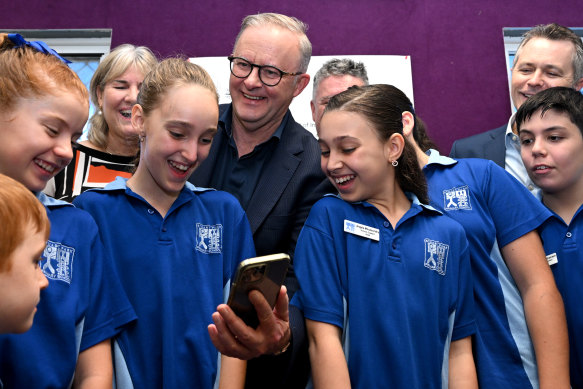- Analysis
- Politics
- Federal
- Social media
This was published 9 months ago
Yes, PM, we should keep kids off the apps. But how, exactly?
By David Crowe
Anthony Albanese has leapt into a social quagmire with a shiny new proposal to spare children from online harm – and he is leaping to the conclusion that voters will thank him.
But the prime minister has made a surprising jump when there are huge doubts about whether the big idea will ever lead to an effective ban on children on social media.

Prime Minister Anthony Albanese is seeking to introduce laws to ban children from social media.Credit: AAP
Is this the right answer? Do parents want it? Can it actually work? Can the government prove to Australians it did its homework before rushing out the news?
There are no sure answers to those questions because Albanese has moved so quickly in the past few days when so many details are yet to be decided.
One essential fact, however, is that Australia has a genuine problem. Public data has shown an increase in mental health hospitalisations and psychological distress among young people. The increase is worst among women and girls aged 16 to 24. This was identified by the Australian Institute of Health and Welfare two years ago; the trend was under way before the pandemic.
“In recent years, the number of young people, especially young females, experiencing psychological distress has been increasing at a greater rate than for other age groups,” it said.
Those findings do not prove that social media is to blame. While the pressure on mental health intensified after the arrival of the iPhone and the rise of Facebook, correlation is not causation. Researchers have more work to do.
A second essential fact is that every major political leader is now backing the age-limit concept. Those who dismiss the idea will try to slow the political momentum, but they may be too late to bring it to a halt.
Albanese has joined a campaign led by Opposition Leader Peter Dutton. In fact, the prime minister has brazenly stolen a Coalition policy after months of Labor dithering. The first mover in parliament on this issue was David Coleman, the opposition communications spokesman, who aired the idea in April. Dutton unveiled the policy in June.
After seizing the Coalition’s plane, Albanese now has to prove it can fly.
Why now? That is the easiest question. South Australian Premier Peter Malinauskas was working on age verification and sought a review by former High Court chief justice Robert French. This went to national cabinet last Friday. Albanese is responding after others pressed for change.
Even so, this is a bad time to add yet another challenge to the government’s agenda. Labor is dragging out a decision on new controls on gambling advertising, struggling to get a deal in parliament on Reserve Bank reform, and waiting for the Coalition to commit to a new aged care funding package. Rather than show progress on these fronts, Albanese comes up with a new idea to add to the to-do list.
The race to announce the idea means nobody is clear on how it will work. The government plans to start an age verification trial, funded with $6.5 million in the May budget, but it has not waited for that trial to start, let alone finish, before announcing its policy. What if the trial demonstrates the enormous technical barriers to making this work?
The initial plan is to use federal law to force social media platforms to meet the new standard, although South Australia proposes a “duty of care” and gives the tech companies a way to show they have taken reasonable steps to verify someone’s age. It is not clear if states want to pass laws to complement a federal scheme. Albanese promises to reveal the law this year; when it passes is another matter.
It is hard to judge how this may work when we do not know how a social media company is meant to verify the user’s age – biometrics, for instance – and we do not know how many platforms will be included. Will this extend to games such as Fortnite, Roblox and Minecraft when they allow children to communicate while they play? Will it drive children to dark corners of the web, where they may be even more vulnerable?
There is not even an agreement on the best age to define as the legal limit. Albanese suggested 16 in a radio interview on Tuesday, in line with Dutton’s proposal in June. Malinauskas suggests 14. This simply confirms that the policy is a general proposal, not a blueprint for change.
All of this looks incredibly hard – and perhaps impossible. It will require more consultation, unity at national cabinet, a review in parliament and, most likely, a bipartisan agreement.
Even so, the concerns about social media are real and the trends in mental health are deeply troubling. The moral response is to do something about it. Years ago, leaders could not figure out what to do, so they did too little. Years later, there is a justified concern that social networks can deepen social problems.
There is, finally, a commitment to act. The onus is on Albanese to prove to parents that his plan can work.
Cut through the noise of federal politics with news, views and expert analysis. Subscribers can sign up to our weekly Inside Politics newsletter.